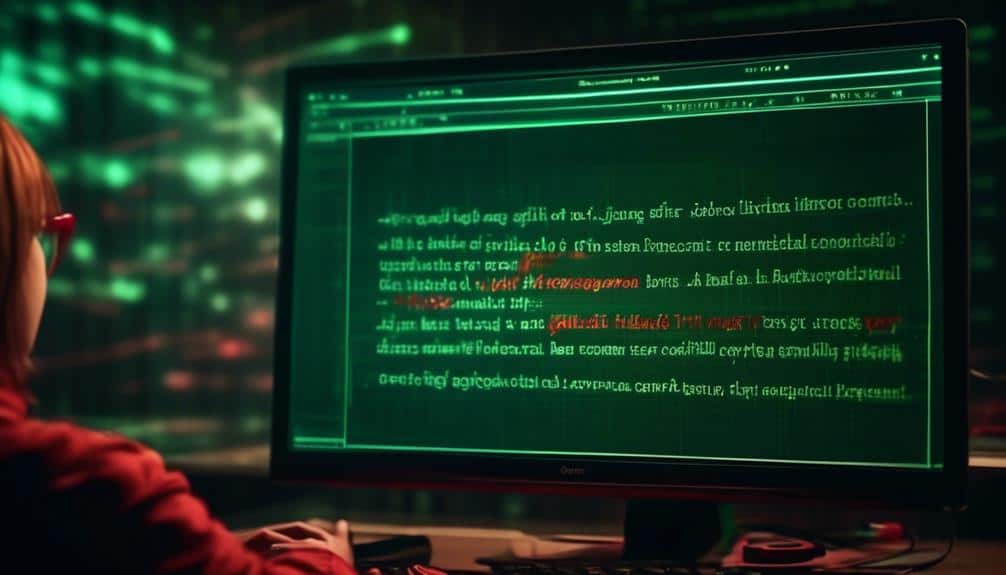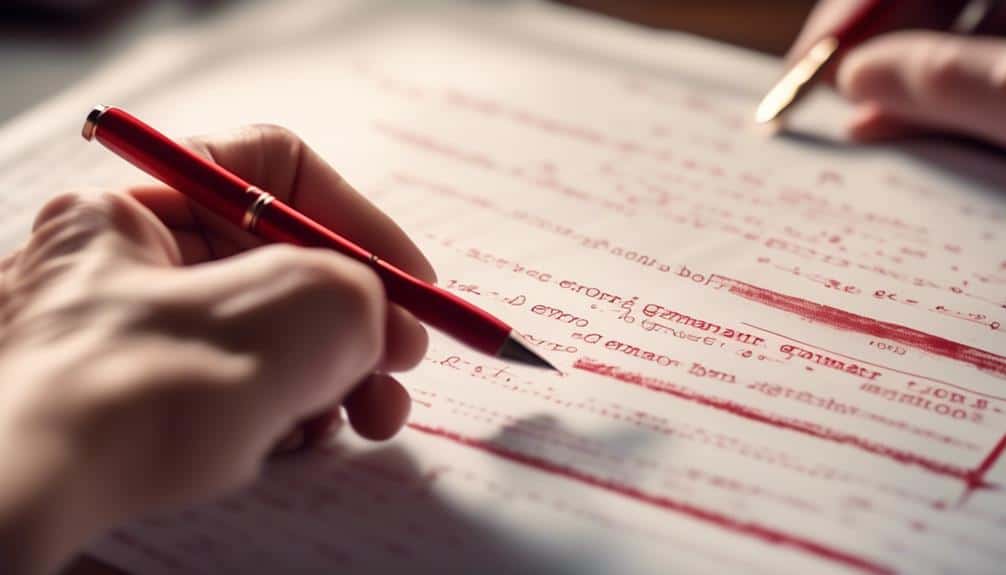Grammar Gurus: Essential Proofreading Tips for Error-Free Writing
In the world of writing, it's often said that 'the devil is in the details.' When it comes to crafting impeccable content, ensuring your work is error-free is paramount.
But how can you guarantee that your writing is polished to perfection? Well, when it comes to grammar gurus and their essential proofreading tips, there's a wealth of knowledge waiting to be shared.
So, if you're striving for flawless communication and want to elevate your writing skills, there's a treasure trove of insights just waiting for you to discover.
Key Takeaways
- Proofreading ensures accuracy and professionalism in writing.
- Double-check commonly confused words like 'your' vs. 'you're' and 'its' vs. 'it's'.
- Utilize tools like Grammarly for real-time error detection.
- Vary sentence length and structure for reader engagement.
The Importance of Proofreading

Proofreading plays a crucial role in ensuring the accuracy and professionalism of your writing. The importance of accuracy can't be overstated when it comes to any written work. Your message, whether it's a business report, academic paper, or even a simple email, must be clear and error-free to convey your ideas effectively. By employing proper proofreading techniques, you can catch spelling mistakes, grammatical errors, and inconsistencies that might otherwise undermine the credibility of your writing.
To prioritize accuracy, start by reviewing your content for spelling and grammar errors. Utilize spell-check tools, but don't rely solely on them. Read your work aloud to catch awkward phrasings or missing words that may have been overlooked. Pay attention to punctuation, ensuring that commas, periods, and other marks are correctly placed. Additionally, check for the consistency of formatting, font styles, and headings throughout your document. Remember, accuracy is key in presenting yourself professionally and effectively to your audience.
Common Grammar Mistakes to Watch For
When reviewing your writing, be vigilant for common grammar mistakes that could detract from the clarity and professionalism of your message. One crucial area to watch out for is subject-verb agreement. Ensure that the subject and verb in each sentence agree in number. For example, saying 'The team is working together' is correct, while 'The team are working together' is incorrect due to the mismatch in singular/plural forms.
Another common error to be mindful of is the misuse of commonly confused words. These words often sound similar but have different meanings or spellings. For instance, confusing 'your' with 'you're' or 'its' with 'it's' can lead to misunderstandings in your writing. Take the time to double-check these words to guarantee you're using the right one in each context.
Tools for Efficient Proofreading

In ensuring your writing is error-free and professional, it's essential to leverage efficient proofreading tools that streamline the process and enhance the accuracy of your work. Here are some valuable tools and techniques to aid you in your proofreading endeavors:
- Online resources: Take advantage of online grammar checkers like Grammarly or ProWritingAid. These tools can quickly identify grammar, punctuation, and spelling errors, providing suggestions for corrections in real-time.
- Proofreading techniques: Implement proofreading techniques such as reading your work aloud. This helps catch awkward phrasings or missing words that your eyes might skip over when reading silently. Another technique is to read your writing backward, starting from the last sentence. This method helps you focus on individual words and their correctness rather than the flow of the content.
- Style guides and dictionaries: Refer to style guides like the AP Stylebook or the Chicago Manual of Style for specific formatting and writing guidelines. Keep a dictionary and thesaurus handy to verify word usage and find suitable alternatives for repetitive terms.
Tips for Spotting Typos and Errors
Enhance your proofreading skills by sharpening your eye for typos and errors. When it comes to spotting typos, spelling accuracy is key. Ensure you pay close attention to every word, checking for common mistakes like missing letters, repeated words, or incorrect homophones. Reading your work aloud can also help identify spelling errors that might be overlooked when reading silently.
Formatting consistency is another crucial aspect to watch out for. Make sure headings, subheadings, font styles, and sizes are uniform throughout your document. Inconsistencies in formatting can be distracting to the reader and detract from the overall professionalism of your writing. Scan your document specifically for these inconsistencies to maintain a polished appearance.
Strategies for Grammar and Punctuation Checks

When proofreading, check for punctuation errors to ensure clarity in your writing.
Reviewing sentence structures can help you identify any grammar issues that need correction.
Make sure to verify the accuracy of your grammar to enhance the overall quality of your writing.
Check for Punctuation Errors
Ensure your writing's clarity and professionalism by meticulously checking for punctuation errors, employing effective strategies for grammar and punctuation checks.
When proofreading for punctuation errors, pay close attention to the following:
- Comma Placement: Check that commas are correctly used to separate items in a list, set off introductory phrases, and separate clauses in a sentence. Incorrect comma placement can alter the meaning of a sentence.
- Apostrophe Usage: Verify that apostrophes are used correctly to indicate possession or to form contractions. Misplaced apostrophes can lead to confusion or grammatical errors.
- Other Punctuation Marks: Look out for proper usage of other punctuation marks like periods, semicolons, colons, and quotation marks. Each serves a specific purpose in clarifying your writing.
Review Sentence Structures
To elevate the quality of your writing and ensure its effectiveness, carefully scrutinize the structures of your sentences for grammar and punctuation accuracy. Pay close attention to sentence flow to guarantee that your ideas are presented in a logical and coherent manner. Structure analysis is crucial in identifying any awkward phrasing or inconsistencies that may disrupt the reader's understanding.
Break down complex sentences into simpler parts to assess each component for clarity and correctness. Ensure that your sentences are varied in length and structure to maintain reader engagement. By reviewing and refining your sentence structures, you can enhance the overall readability and impact of your writing.
Verify Grammar Accuracy
As you refine your sentence structures for clarity and correctness, it's essential to implement effective strategies for ensuring the accuracy of grammar and punctuation in your writing.
To verify grammar accuracy, consider the following:
- Brush up on Grammar Rules: Regularly review common grammar rules to avoid errors in your writing.
- Enhance Your Writing Skills: Continuously work on improving your writing skills by reading, practicing, and seeking feedback.
- Utilize Grammar Tools: Make use of grammar-checking tools or software to catch any overlooked mistakes and enhance the overall quality of your writing.
Final Steps for Error-Free Writing

To finalize your error-free writing, meticulously review your work with a fresh perspective before submitting for publication or sharing with others. Start by ensuring consistent formatting throughout your document. Check that headings, font styles, and spacing are uniform to create a polished appearance. Additionally, proper citation is crucial to maintain credibility and avoid plagiarism. Double-check all references, quotes, and sources to comply with the required citation style.
Next, focus on the overall structure of your writing. Confirm that your introduction is engaging, the body is coherent, and the conclusion is impactful. Ensure smooth transitions between paragraphs and ideas for a seamless reading experience. Pay attention to detail by verifying the accuracy of facts, figures, and any statistical data presented in your work.
Lastly, perform a thorough proofread for spelling, grammar, and punctuation errors. Use digital tools like spell checkers, but don't rely solely on them. Read your work aloud or ask someone else to review it to catch any overlooked mistakes. By following these final steps, you can present error-free writing that effectively communicates your message.
Frequently Asked Questions
What Are Some Common Misconceptions About Proofreading?
When proofreading, you might fall into common pitfalls like relying too much on spell check. Misguided beliefs include thinking grammar rules never change. Stay vigilant; proofreading demands precision and flexibility to catch errors effectively.
How Can I Effectively Proofread My Writing for Tone and Clarity?
To effectively proofread for tone and clarity, start by performing a clarity check to ensure your message is clear. Next, conduct a tone analysis to confirm the intended emotional impact. These steps enhance communication and engagement.
Are There Any Specific Techniques for Proofreading Long Documents or Manuscripts?
When proofreading long documents or manuscripts, utilize time management by breaking the task into manageable sections. Engage in visual scanning to identify errors efficiently. This approach aids in maintaining focus and enhancing the overall quality of your work.
What Should I Do if I'm Still Finding Errors After Multiple Rounds of Proofreading?
If you're still spotting errors after rounds of proofreading, try additional strategies like taking breaks, changing your proofreading environment, or reading your text aloud. If needed, consider professional assistance or online tools for frustration relief.
Is There a Difference Between Proofreading for Different Types of Writing, Such as Academic Papers Versus Creative Writing?
When proofreading, consider differences between academic and creative writing. Academic writing tends to be formal, requiring precise language and adherence to style guides. Creative writing allows for more informal expression, focusing on capturing emotions and vivid imagery.
Conclusion
Proofreading is a crucial step in ensuring error-free writing. By being vigilant and using tools to assist you, you can catch common grammar mistakes and typos.
Remember to pay attention to detail, use proper grammar and punctuation, and take the time to thoroughly review your work.
With these essential proofreading tips, you can confidently present polished and professional writing every time.








